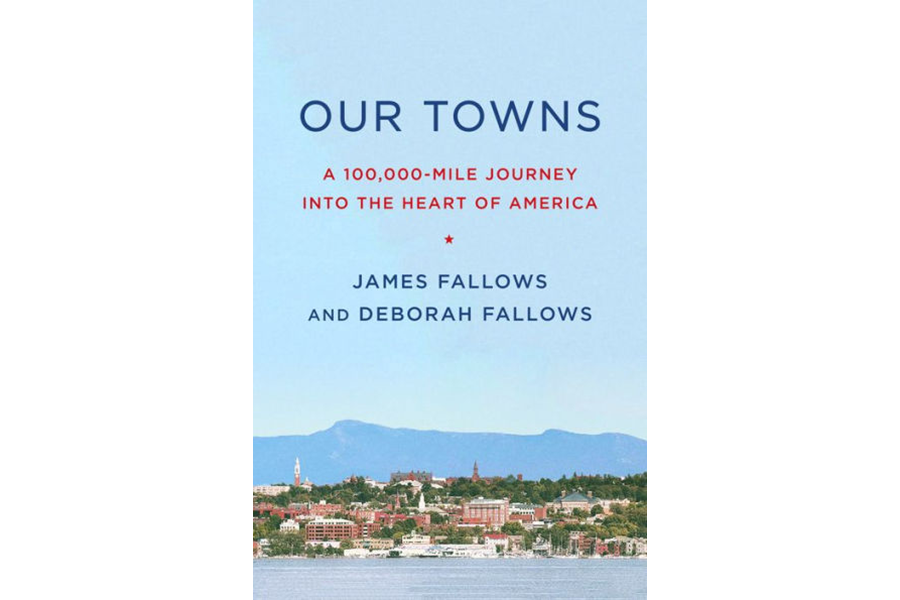'Our Towns' finds optimism in America's smaller cities
Loading...
While reflecting on the many cities she and her husband James visited during their reporting, Deborah Fallows recalls an interaction she noticed everywhere they went. She calls it “The Question.” Put simply, it’s the line that follows “Nice to meet you,” in an conversation with someone new. In big, transient cities like Seattle and Los Angeles, people ask “Where are you from?” In St. Louis, “Where did you go to high school?” In New Orleans, “Who’s your mama?” “It’s a question,” Ms. Fallows writes, “something like ‘So, what’s your story?’”
In Our Towns, co-written by the two journalists, the Question is not only a fun quirk of linguistic geography. It is the driving force behind the writers’ five-year journey across the US. Adapted from a series for the Atlantic, “Our Towns” traverses the continent via passenger plane (James is a licensed pilot) spotlighting communities with their own stories to tell.
The book’s premise is simple: the ongoing national political debate – built on the image of a stalemated federal government unable to seek common ground – misses major economic and social successes happening in cities all over the country.
“The point that comes back to us is the starkness of the contrast: on the one hand, the flattened terms – ‘angry,’ ‘resentful,’ ‘hopeless’ – the language the media and politicians use to describe American in general; on the other hand, the engaged, changing realities people understand about the places where they actually live,” James writes.
The Fallows follow innovations like the construction of heated pipes under Holland, Mich., to reinvigorate its pedestrian downtown during the snowy winter and the Mississippi School for Mathematics and Science in Columbus, Mississippi, a public boarding school that brings together students from all socioeconomic backgrounds across the Delta to build a pool of talented and diverse local STEM professionals.
Hope seeps into every page of this book, even in the language itself. Instead of referring to downtown Fresno, Calif., as “rundown” or “blighted,” James calls it “an example of the ‘before’ stage of civic recovery,” and then references what he admits is a cheesy, though effective slogan behind its urban revitalization: “Fresno? It’s Fres-yes!”
The Fallows’s method of travel is also critical to their story-telling. It’s cliche, maybe, to say that social divisions – state and city borders, the gaps between wealthy and poor neighborhoods – disappear when examined from 10,000 feet above the ground. But even so, there is something powerful about imagining how the peaks of the Sierra Nevada mountains fall away into California’s dry agricultural Central Valley or how the mighty Big Sioux River carves straight through the sprawling acres of Sioux Falls, S.D. The Fallows are intent on depicting US cities not as isolated data entries but as part of one continuous American landscape.
Beyond documenting the contours of urban life most often ignored in national news, the book mainly serves as an instruction manual. At the end, the writers unveil a list of the key elements found in thriving towns. It reads almost like a recipe. To foster successful cities, start with a strong civic story. Toss in community colleges and proximity to a research university. Season with public-private partnerships and an openness to immigrants, and serve with a healthy dose of ambition. The message here is straightforward and earnest: These are the steps to making life better for the place where you live.
One of the last cities the book explores is Erie, Pa. – a community that played a critical role in 2016’s national election as a depiction of a largely white Rust Belt town that struggled with job loss and aging infrastructure; the implied present following the golden past of “Make America Great Again” rhetoric. The state’s penny-pinching school funding program has choked educational resources here and the General Electric Transportation Plant has been transferring thousands of jobs here to Texas and elsewhere.
Despite these hardships, the Fallows felt a tangible sense of optimism. More than growing job training programs and a burgeoning tech start-up business accelerator, it was a change in the town’s outlook that signaled the region’s biggest transformation. “It was so impressive to find a group of next-generation Erieites … who look at the inexpensive real estate and still-present manufacturing infrastructure and see possibilities opening rather than closing,” James writes.
And throughout much of the book, that sense of possibility comes from one particular population that challenges contemporary urban defeatism: immigrants and refugees.
Mohamed Zkrit arrived in Erie with his wife and four children after fleeing war in Syria. The Fallows are careful not to romanticize the experience of Mr. Zkrit’s family in the US. As a recent arrival with few English language skills, Zkrit will likely take on a near-minimum wage job in order to afford his family’s meagerly furnished one-floor apartment. Even so, when James asks him about Erie, Zkrit is able to see beyond the popular images of post-industrial stagnation and express his hope to build a permanent home here.
“American is a dream country,” he says.






